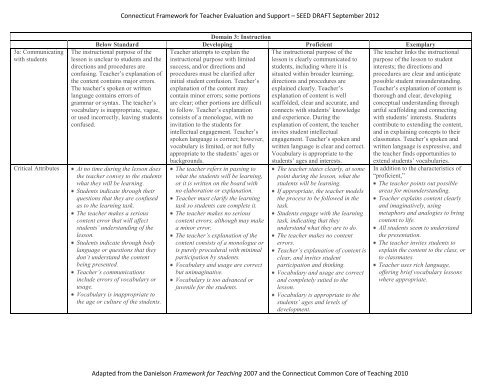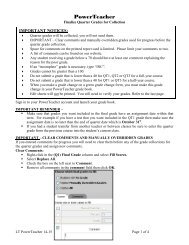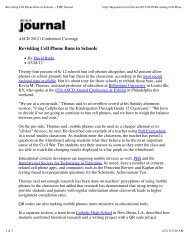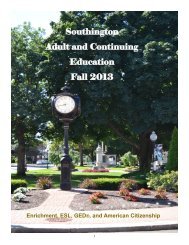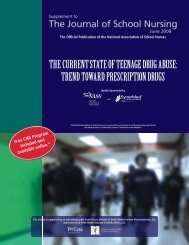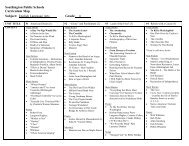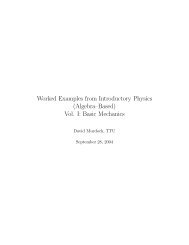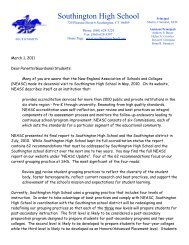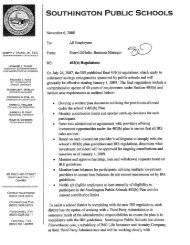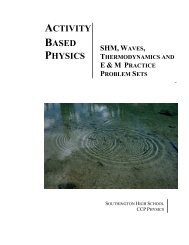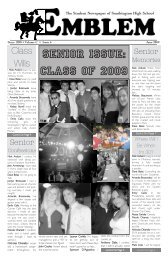Connecticut Framework for Teacher Evaluation and Support â SEED ...
Connecticut Framework for Teacher Evaluation and Support â SEED ...
Connecticut Framework for Teacher Evaluation and Support â SEED ...
You also want an ePaper? Increase the reach of your titles
YUMPU automatically turns print PDFs into web optimized ePapers that Google loves.
<strong>Connecticut</strong> <strong>Framework</strong> <strong>for</strong> <strong>Teacher</strong> <strong>Evaluation</strong> <strong>and</strong> <strong>Support</strong> – <strong>SEED</strong> DRAFT September 2012<br />
3a: Communicating<br />
with students<br />
Critical Attributes<br />
Domain 3: Instruction<br />
Below St<strong>and</strong>ard Developing Proficient Exemplary<br />
<strong>Teacher</strong> attempts to explain the The instructional purpose of the The teacher links the instructional<br />
instructional purpose with limited lesson is clearly communicated to purpose of the lesson to student<br />
success, <strong>and</strong>/or directions <strong>and</strong> students, including where it is interests; the directions <strong>and</strong><br />
procedures must be clarified after situated within broader learning; procedures are clear <strong>and</strong> anticipate<br />
initial student confusion. <strong>Teacher</strong>’s directions <strong>and</strong> procedures are possible student misunderst<strong>and</strong>ing.<br />
explanation of the content may explained clearly. <strong>Teacher</strong>’s <strong>Teacher</strong>’s explanation of content is<br />
contain minor errors; some portions explanation of content is well thorough <strong>and</strong> clear, developing<br />
are clear; other portions are difficult scaffolded, clear <strong>and</strong> accurate, <strong>and</strong> conceptual underst<strong>and</strong>ing through<br />
to follow. <strong>Teacher</strong>’s explanation connects with students’ knowledge artful scaffolding <strong>and</strong> connecting<br />
consists of a monologue, with no <strong>and</strong> experience. During the<br />
with students’ interests. Students<br />
invitation to the students <strong>for</strong> explanation of content, the teacher contribute to extending the content,<br />
intellectual engagement. <strong>Teacher</strong>’s invites student intellectual<br />
<strong>and</strong> in explaining concepts to their<br />
spoken language is correct; however, engagement. <strong>Teacher</strong>’s spoken <strong>and</strong> classmates. <strong>Teacher</strong>’s spoken <strong>and</strong><br />
vocabulary is limited, or not fully written language is clear <strong>and</strong> correct. written language is expressive, <strong>and</strong><br />
appropriate to the students’ ages or Vocabulary is appropriate to the the teacher finds opportunities to<br />
backgrounds.<br />
students’ ages <strong>and</strong> interests. extend students’ vocabularies.<br />
The instructional purpose of the<br />
lesson is unclear to students <strong>and</strong> the<br />
directions <strong>and</strong> procedures are<br />
confusing. <strong>Teacher</strong>’s explanation of<br />
the content contains major errors.<br />
The teacher’s spoken or written<br />
language contains errors of<br />
grammar or syntax. The teacher’s<br />
vocabulary is inappropriate, vague,<br />
or used incorrectly, leaving students<br />
confused.<br />
At no time during the lesson does<br />
the teacher convey to the students<br />
what they will be learning.<br />
Students indicate through their<br />
questions that they are confused<br />
as to the learning task.<br />
The teacher makes a serious<br />
content error that will affect<br />
students’ underst<strong>and</strong>ing of the<br />
lesson.<br />
Students indicate through body<br />
language or questions that they<br />
don’t underst<strong>and</strong> the content<br />
being presented.<br />
<strong>Teacher</strong>’s communications<br />
include errors of vocabulary or<br />
usage.<br />
Vocabulary is inappropriate to<br />
the age or culture of the students.<br />
The teacher refers in passing to<br />
what the students will be learning,<br />
or it is written on the board with<br />
no elaboration or explanation.<br />
<strong>Teacher</strong> must clarify the learning<br />
task so students can complete it.<br />
The teacher makes no serious<br />
content errors, although may make<br />
a minor error.<br />
The teacher’s explanation of the<br />
content consists of a monologue or<br />
is purely procedural with minimal<br />
participation by students.<br />
Vocabulary <strong>and</strong> usage are correct<br />
but unimaginative.<br />
Vocabulary is too advanced or<br />
juvenile <strong>for</strong> the students.<br />
The teacher states clearly, at some<br />
point during the lesson, what the<br />
students will be learning.<br />
If appropriate, the teacher models<br />
the process to be followed in the<br />
task.<br />
Students engage with the learning<br />
task, indicating that they<br />
underst<strong>and</strong> what they are to do.<br />
The teacher makes no content<br />
errors.<br />
<strong>Teacher</strong>’s explanation of content is<br />
clear, <strong>and</strong> invites student<br />
participation <strong>and</strong> thinking.<br />
Vocabulary <strong>and</strong> usage are correct<br />
<strong>and</strong> completely suited to the<br />
lesson.<br />
Vocabulary is appropriate to the<br />
students’ ages <strong>and</strong> levels of<br />
development.<br />
In addition to the characteristics of<br />
“proficient,”<br />
The teacher points out possible<br />
areas <strong>for</strong> misunderst<strong>and</strong>ing.<br />
<strong>Teacher</strong> explains content clearly<br />
<strong>and</strong> imaginatively, using<br />
metaphors <strong>and</strong> analogies to bring<br />
content to life.<br />
All students seem to underst<strong>and</strong><br />
the presentation.<br />
The teacher invites students to<br />
explain the content to the class, or<br />
to classmates.<br />
<strong>Teacher</strong> uses rich language,<br />
offering brief vocabulary lessons<br />
where appropriate.<br />
Adapted from the Danielson <strong>Framework</strong> <strong>for</strong> Teaching 2007 <strong>and</strong> the <strong>Connecticut</strong> Common Core of Teaching 2010


